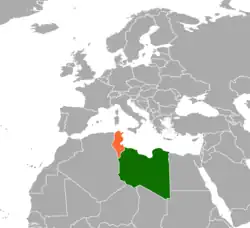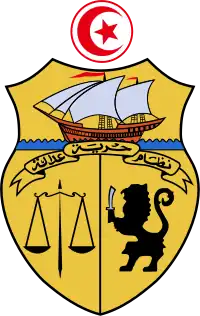Libya–Tunisia relations
Libyan–Tunisian relations are longstanding between the two neighbouring North African Maghreb states, Libya and Tunisia.
 | |
Libya |
Tunisia |
|---|---|
Being the two neighboring Maghreb nations, the relationship between the two is friendly but sometimes rocky. Tunisia is known to have some issues with Libya including political differences.
Libya has an embassy in Tunis whilst Tunisia maintains a Consulate in Tripoli, the Tunisian Embassy has been closed since 2015 due to security concerns. Both countries are members of the Organisation of Islamic Cooperation, African Union, Arab League and Non-Aligned Movement.
History
Ever since Carthage started expanding into the Mediterranean, Tunisia has held control over Tripolitania (modern-day north western Libya) for centuries under various dynasties and kingdoms who kept the region under their control. Both Tunisia and Libya were Islamized and Arabized upon the Muslim conquest of the Maghreb and were part of various emirates and Caliphates that ruled the region, such as the Aghlabids, Fatimids, Zirids and the Hafsids. In the 16th century, they were absorbed into the Ottoman Empire as two distinct provinces until the Scramble for Africa began when France and Italy acquired control over them.
In the 1950s, both countries gained independence and established relations when Libyan King Idris and Tunisian President Habib Bourguiba were the representatives for each country, respectively.
Libyan Civil War
.jpg.webp)
Tunisia, where the Arab Spring began, later spread into Libya and overthrew the regimes of both countries; however, the 2011 Libyan unrest had gone out of control after the death of Muammer Gaddafi caused the later second Libyan unrest which the growing Islamists tried to take control, Tunisia has been caught at the amidst of the conflict in Libya between the Tobruk-based Representatives and the Tripoli-based National Congress.[1]
Tunisia's relations with Libya have been characterized as rocky, since the Ennahda Movement party of the Tunisian government has shown to be sympathetic with Islamists ruling Tripoli (Government of National Accord), thus causing a drift between the two nations. However, the official Tunisian diplomatic stance is to remain neutral in the affairs of other Maghreb nations.[2]
Nonetheless, Tunisia has been a critical supporter for reconciliation between the two government factions in Libya, alongside Egypt and Algeria.[3] Tunisia also kept its borders open for Libyan and International refugees fleeing the war, accepting over two million Libyan citizens into the country in 2015.[4]
Border
The two countries share 460 km of border, designated by the Tunisian MoD as buffer zones with specified coordinates, special authorization is required to enter these zones.
Tunisia constructed a defensive line alongside its borders with Libya, a physical barrier composed of a system of obstacles, including sandbags protecting water-filled trenches dug about 2 meters deep, elevated observation towers, and fences. With the assistance of Germany and the US, Tunisia installed an electronic security surveillance along its completed barrier that spans almost half of the border's length, the surveillance system comprises unmanned aerial vehicle (UAV) systems which are used to complement the camera-based security surveillance system. The remaining half of the borders south of Dehiba consists of a vast ocean of sand dunes which are monitored by Tunisian Army's GTS "(in French): Groupement Territorial Saharien", an army corps specialized in the Saharan environment, supported by aerial reconnaissance.
In August 2023, Tunisia and Libya reached a cooperation agreement to share the reception of sub-Saharan African migrants stranded at the border between the two countries.[5]
References
- "Crisis and resilience in Libya and Tunisia". 21 September 2016.
- "Shifting relations between Tunisia, Libya". Al-Monitor. 29 May 2015.
- Nawal Sayed (18 December 2017). "Egypt, Tunisia, Algeria assert adherence to dialog to solve Libya crisis". Egypt Today.
- "The impact of Libyan middle-class refugees in Tunisia". 17 March 2015.
- "La Tunisie et la Libye trouvent un accord pour accueillir les migrants bloqués à la frontière". Le Monde. 2023-08-10. Retrieved 2023-08-25.
.svg.png.webp)
